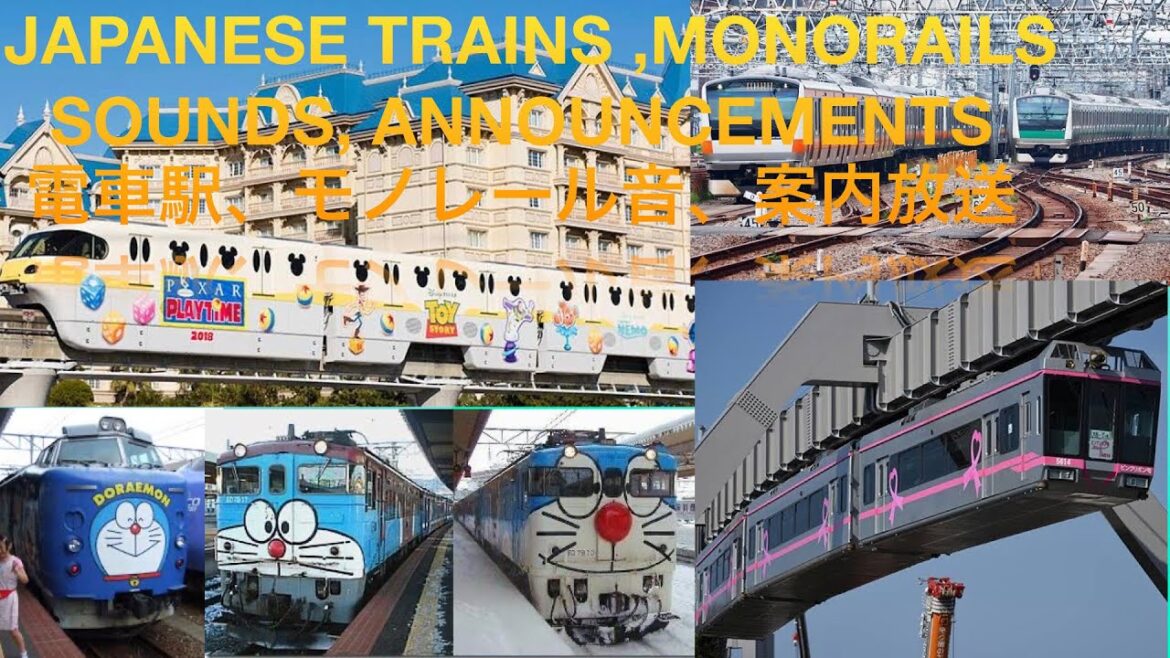1.) JAPANESE TRAINS,MONORAILS AND ITS ANNOUNCEMAENT STYLES:-
Japan has a long history of trains and railways, dating back to the late 19th century. The first railway line in Japan, which connected Tokyo to Yokohama, was opened in 1872. Since then, Japan has developed a highly advanced and extensive railway system, including both conventional trains and monorails.
Japanese trains are known for their speed, punctuality, and safety. The famous “bullet trains,” or Shinkansen, were first introduced in 1964 and are capable of reaching speeds of up to 320 km/h (200 mph). These trains have become a symbol of Japan’s technological prowess and efficiency.
In addition to conventional trains, Japan also has a number of monorail systems. The first monorail in Japan was built in Osaka in 1963, and since then, several other monorails have been constructed in different parts of the country.
Japanese trains and monorails are also known for their distinctive announcement styles. Train announcements in Japan are typically made in a clear and concise manner, with a focus on providing accurate and useful information for passengers. In addition, many train announcements are made in multiple languages, including English, Chinese, and Korean, to accommodate international travelers.
The announcement styles themselves vary depending on the line and the operator, but they generally follow a similar pattern. Announcements typically include information about the current station, the next station, and any connecting lines or transfers that passengers may need to make. They may also include information about delays, service disruptions, or other relevant news.
Some train lines in Japan also have their own unique announcement styles. For example, the Yamanote Line in Tokyo is known for its friendly and upbeat announcements, while the Chuo Line is known for its calm and soothing announcements.
Overall, the history of Japanese trains and monorails is closely tied to the country’s culture of efficiency, innovation, and attention to detail. From the first railway lines in the late 19th century to the high-speed Shinkansen trains of today, Japan’s railway system is a testament to the country’s ongoing commitment to technological advancement and excellence.
2.)MY EXPERIENCE OF LIVING IN JAPAN AND USING JAPANESE TRAINS AND MONORAILS
Japan is known for its high-quality infrastructure and public transportation system, which includes an extensive network of trains and monorails. Living in Japan and using these modes of transportation can be an incredibly convenient and efficient experience.
One of the benefits of using Japanese trains and monorails is their punctuality. Trains in Japan are known for running on time and arriving at their destination according to schedule. This reliability can be particularly helpful for commuters who need to arrive at work or school on time.
Another advantage of using Japanese trains and monorails is their cleanliness and comfort. Trains and monorails in Japan are generally well-maintained and kept clean, providing a comfortable environment for passengers to travel in.
In addition, many Japanese trains and monorails are equipped with modern amenities such as Wi-Fi, power outlets, and vending machines selling food and drinks. This can make traveling long distances more comfortable and convenient.
However, using Japanese trains and monorails can also be overwhelming for those who are unfamiliar with the system. The train and monorail network in Japan is extensive and complex, and it can be difficult to navigate without prior knowledge of the routes and schedules.
Moreover, purchasing tickets for trains and monorails can also be confusing, especially for those who do not speak Japanese. However, most train stations in Japan have English signage and staff who can assist foreign travelers.
In summary, living in Japan and using Japanese trains and monorails can be an enjoyable and convenient experience due to their reliability, cleanliness, and modern amenities. However, navigating the system can be overwhelming for those who are unfamiliar with it, but English signage and helpful staff can make the experience more manageable.
日本の電車に私の経験
日本の電車やモノレールは、信頼性、清潔さ、快適さなどの点で高い評価を得ています。これらの公共交通機関を利用することで、効率的で便利な移動が可能になります。
日本の電車やモノレールの利点の一つは、時刻表通りに運行することです。日本の電車は時間通りに運行することで知られており、仕事や学校に時間通りに到着する必要がある通勤者にとっては特に便利です。
また、日本の電車やモノレールは一般的に清潔で快適な環境を提供しています。車両のメンテナンスが行き届いており、乗客が快適に移動できます。
さらに、多くの日本の電車やモノレールには、Wi-Fi、電源コンセント、飲食物の自動販売機など、現代的な設備が備わっています。これにより、長距離移動をより快適に便利にすることができます。
ただし、日本の電車やモノレールの利用は、システムに慣れていない人にとっては混乱することがあります。日本の列車やモノレールのネットワークは広範囲で複雑であり、路線や時刻表を事前に把握しないと迷うことがあります。
さらに、日本の電車やモノレールのチケットの購入は、日本語を話せない人にとっても混乱することがあります。ただし、日本の駅には英語の案内やスタッフがおり、外国人旅行者にも対応しています。
まとめると、日本の電車やモノレールを利用することで、信頼性、清潔さ、現代的な設備などの利点を享受できます。
#ビスタ#bista#japanesetrains #japantravel #japanese #japanesefood #fukuokajapan #japaneselifestyle #japanvlog #japaneseculture #japanmonorails #japanbullettrain#japantrains #japanthings #jp


3 Comments
those duuddududu sounds (tone ) made me JAPAN missing so much
🚅🚅日本の電車素晴らしいようね。。。。。
Wow nice